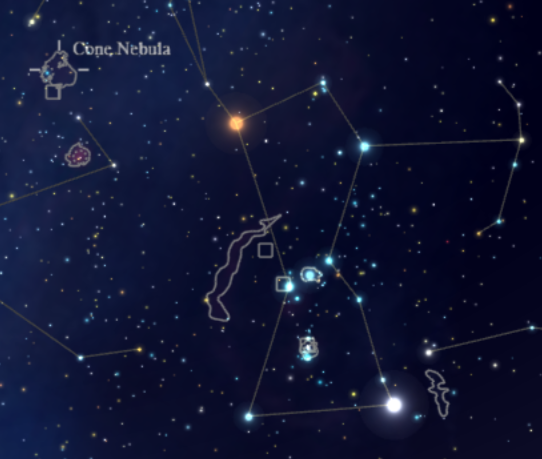Cone Nebula and Christmas Tree cluster
03/27/25
The Cone Nebula (NGC 2264) – A Tower of Darkness in a Nursery of Stars
Shining to the east and north of Orion in midwinter, the Cone Nebula is a striking, dark, conical-shaped region of cold gas and dust silhouetted against the glowing backdrop of an emission nebula. It lies within the NGC 2264 region of the constellation Monoceros, which also includes the Christmas Tree Cluster and the Fox Fur Nebula. Together, these form a rich and active star-forming complex roughly 2,700 light-years from Earth. The Cone Nebula is not visible to the naked eye.
The Cone’s shape—resembling a shadowy pillar or spire—is one of the most iconic examples of a Bok globule and is a dramatic reminder of how radiation from massive stars sculpts the interstellar medium.
Distance and Size
- Distance: ~2,700 light-years
- Apparent Size: The Cone itself spans about 7 arcminutes in length
- Actual Size: ~7 light-years long
Although part of a much larger region, the Cone Nebula is a compact, dense pillar of gas extending into the larger NGC 2264 H II region.
Structure and Features
The Cone is a pillar of cold molecular gas and dust, shaped by the stellar winds and radiation from young, hot stars in the region. Its dark appearance comes from silhouetting against the red glow of ionized hydrogen in the background. The conical shape is due to:
- Radiation-driven erosion from nearby stars
- Photoevaporation of the less dense outer layers
- Resistance from dense cores inside the cloud, possibly forming new stars
This sculpting process leaves behind towering columns, with bright-rimmed edges and potential protostars hidden inside.
Illuminating Stars and the Christmas Tree Cluster
The surrounding emission nebula (NGC 2264) is illuminated primarily by S Monocerotis, a young, hot O7V star located near the top of the “Christmas Tree.”
- Spectral Type: O7V
- Surface Temperature: ~37,000 K
- Luminosity: ~100,000 times the Sun
- Age: ~<5 million years
S Mon and other massive members of the Christmas Tree Cluster emit powerful ultraviolet radiation, which ionizes the hydrogen gas in the surrounding nebula, causing it to glow and shaping denser structures like the Cone.
Star Formation
The Cone Nebula lies at the tip of an active star-forming pillar. Infrared observations and radio imaging from Spitzer and Herschel reveal:
- Embedded protostars along the dark pillar
- Young stellar objects (YSOs) forming in nearby dusty clumps
- A feedback loop where massive stars compress the molecular cloud, triggering more star formation
This area is part of the larger Monoceros OB1 molecular cloud complex, a stellar nursery rich in dense gas and bright emission regions. The Cone Nebula is a dark, dense tower of gas in a glowing star-forming region, beautifully silhouetted against the emission of surrounding hydrogen. At about 2,700 light-years away, this striking structure is not only photogenic but a living example of how massive stars shape their environment. As part of the broader NGC 2264 complex, the Cone is both a symbol of stellar birth and a dynamic object still evolving under the powerful influence of its stellar neighbors. It remains a winter sky favorite and a deep-space symbol of cosmic creation.
Project Details
-
Belleville, MI
-
ZWO FF65 telescope with .75 reducer. FL = 308mm, f4.8, Pentax K3ii, 4 minute subs, Antlia Triband Filter, 6h33m integration time. 40 second subs iso4000



